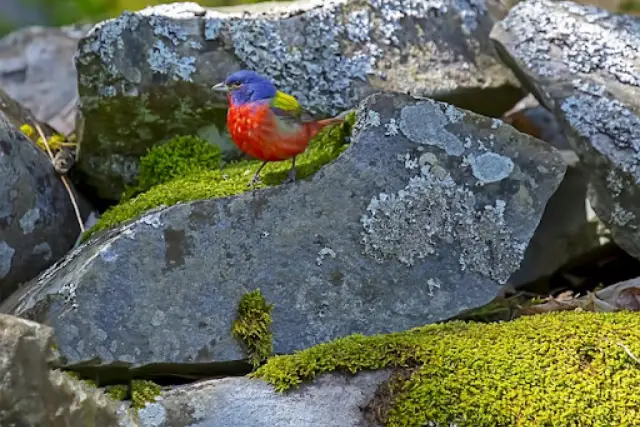Generally, birds are available in a wide assortment of colors: some are flashy, neutral while others are dull. Therefore, most bird lovers use their plumage colors to identify them; after all, they do have different color patterns on their plumages.
So if you're finding it hard to identify a bird with red chest that frequents your backyard, you have come to the right place. In this article, we'll help you identify the different birds with red chests by their description, call, and behavior.
So let's dive right in...
10 Birds With Red Chests
1. Painted Bunting (Passerina ciris)
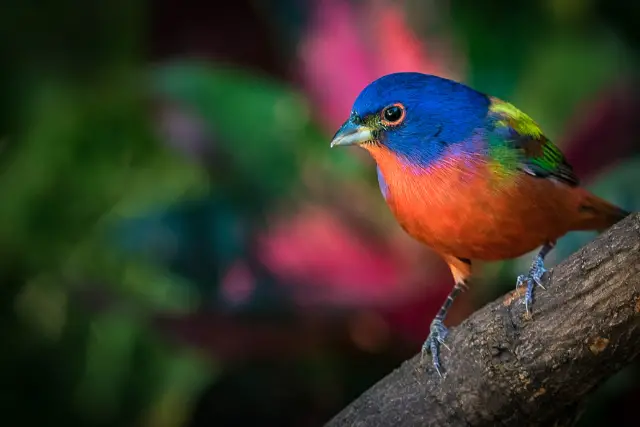
The Painted Bunting is a small, colorful bird found in North America and Central America. The Painted Bunting is a highly sought-after bird for birdwatchers due to its stunning appearance and relatively elusive nature. Its vibrant plumage and enchanting song make it a true gem in the avian world.
The male Painted Bunting is often regarded as one of the most beautiful birds in North America due to its vibrant plumage.
The male Painted Buntings have a striking appearance. Their head is a deep blue color, blending into a green back and a bright red chest. They have a blue eye ring and dark blue or blackish wings and tails. The combination of blue, green, and red on the male's plumage creates a stunning and eye-catching display.
In contrast, female Painted Buntings have a more subdued appearance. They have greenish upper parts, a yellowish-green breast, and pale eye rings. Juvenile birds resemble females but with even less pronounced colors.
Painted Buntings are primarily found in the southeastern United States during the breeding season, with some populations migrating to Mexico and Central America during winter. They prefer dense shrubby habitats such as thickets, hedgerows, and brushy areas.
These birds are known for their beautiful and melodious song, which consists of a series of musical notes and trills. Males often sing from a hidden perch within their territory to attract females and establish their breeding presence.
In terms of diet, Painted Buntings primarily consume seeds, fruits, and insects. They are known to visit backyard feeders that offer appropriate food, such as sunflower seeds in Central America.
2. Scarlet Robin (Petroica boodang)
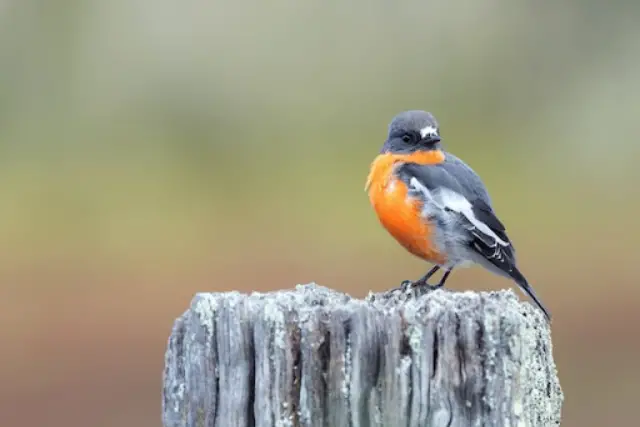
The scarlet robin is a small bird species with a bright red chest that belongs to the family Petroicidae. The scarlet robin is a beautiful and charismatic bird that adds vibrant colors to the Australian avian fauna.
In fact, its striking appearance and melodious song make it a favorite among birdwatchers and nature enthusiasts.
Like some of the birds with red chests, the scarlet robin exhibits sexual dimorphism, with the males and females having different plumage. The male scarlet robin has a distinctive scarlet or reddish-orange breast and face, contrasting with a black head, back, and wings.
The upper parts are black, while the underparts are bright scarlet. On the other hand, the female scarlet robin has a more subdued coloration, with a grey-brown head, back, and wings and a pale orange breast.
Scarlet robins inhabit a variety of forested habitats, including wet and dry sclerophyll forests, woodland areas, and shrublands. They can also be found in parks and gardens, especially during the winter months when they may venture into more urban areas.
The mating season for scarlet robins generally occurs from August to January. The female constructs a cup-shaped nest made of grass, bark, and other plant materials, usually placed on a tree fork or against the trunk. The female incubates the eggs while the male assists with feeding during this period.
Like most birds with red chests, this species resides in the grasslands, wetlands, and tropical forests.
3. Purple Finch (Haemorhous purpureus)
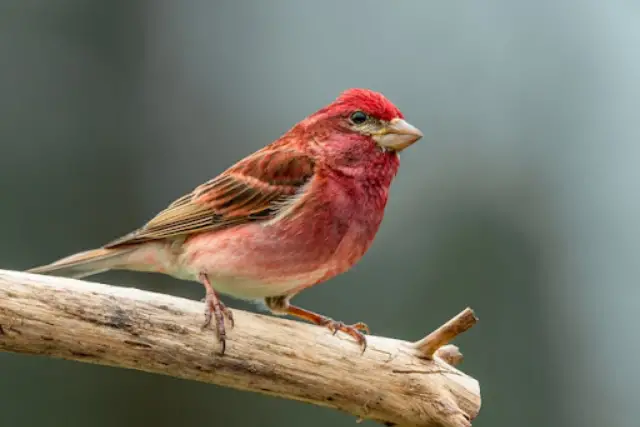
The purple finch is a small songbird species with a red chest that belongs to the family Fringillidae. This bird is known for its beautiful plumage and pleasant, melodious song. Its presence adds color and charm to the avian community of North America, making it a delight for birdwatchers.
The male purple finch has rich, bright red plumage on its head, breast, back, and rump. Their wings and tail are brown, and the belly is white with streaks.
The red coloration is more vibrant during the mating season and may fade to a duller shade during winter.
On the other hand, the female purple finch has a brown overall plumage with streaks and a whitish eyebrow stripe. Both males and females have a conical beak, ideal for cracking seeds.
Purple finches are one of the bird species with red chests that are native to North America and can be found in a variety of habitats, including coniferous and mixed forests, as well as suburban areas with trees and shrubs. During the breeding season, they tend to prefer higher elevations.
Purple finches forage in trees and shrubs, hopping along branches and using their beaks to extract seeds. They can also be attracted to bird feeders that offer sunflower seeds and other suitable seeds. Purple finches typically breed from April to August.
You’ll find a wide array of the best brands of seed mixes in the market at the most affordable prices.
4. White Winged Crossbill (Loxia leucoptera)
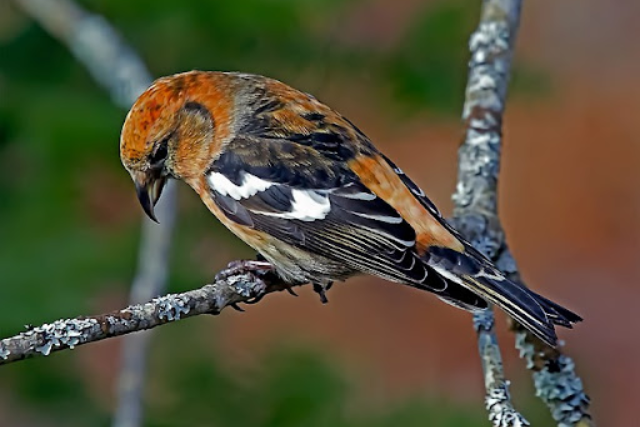
The white-winged crossbill is a small passerine bird that belongs to the finch family, Fringillidae. Like some birds, these fascinating birds with their specialized bill adaptation and nomadic behavior. They are unique-looking bird with a stout beak that crosses at the tips.
This cross-shaped bill is specially adapted for prying open the cones of coniferous trees to access the seeds inside. They have specialized tongues with grooves that help extract and swallow the seeds.
The diet of white-winged crossbills primarily consists of conifer seeds, particularly those of spruce and pine trees.
The plumage of male white-winged crossbills varies depending on the subspecies, but they generally have red or pinkish-red coloration on their body, wings, and tail. Their wings also exhibit distinct white wing bars, which give the bird its name.
On the other hand, the females and immature birds have more subdued coloration, often with a mix of olive, yellow, and gray tones.
White-winged crossbills are found in boreal forests across the northern regions of North America, Europe, and Asia. They prefer coniferous habitats, such as spruce, fir, and pine forests, where they rely on the abundance of conifer cones for food.
White-winged crossbills breed during the spring and summer months. They are known for their nomadic and irruptive behavior, which means their breeding patterns can be irregular and depend on the availability of cone crops.
5. Red-Breasted Sapsucker (Sphyrapicus ruber)
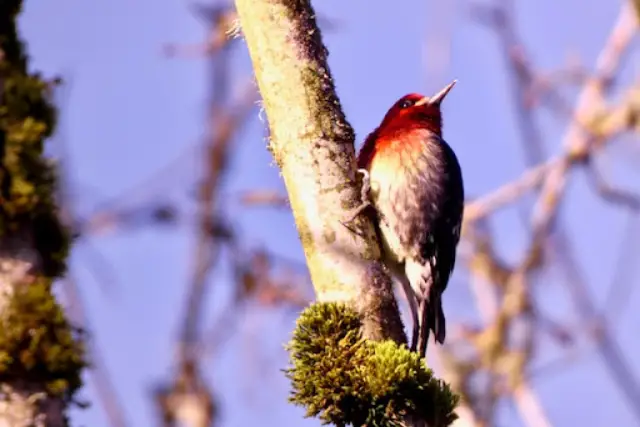
The red-breasted sapsucker is a species of woodpecker with red chests that is found in western North America. This interesting woodpecker species is known for its sap-drilling behavior. Its vibrant plumage and unique feeding habits make it a captivating sight for North American birdwatchers.
This stunning bird is a medium-sized woodpecker with distinct plumage. The adult male has a black head, a red throat, and bright red breast. Their back and wings are black with white barring, and the underparts are white.
The adult female red-breasted sapsucker is similar but with a black throat instead of red feathers. Juvenile birds have a more mottled appearance with less distinct markings.
As their name suggests, red-breasted sapsuckers have a unique feeding behavior. They drill small, evenly spaced holes in tree bark, forming horizontal or sometimes vertical rows. These holes are called sap wells.
The sapsuckers return to these sap wells repeatedly to consume the sap and insects that get trapped in the sticky substance. They may also eat the inner bark and cambium of the trees. This feeding behavior can sometimes be harmful to the trees but can also create food sources for other birds and insects.
6. Rose Breasted Grosbeaks (Pheucticus ludovicianus)
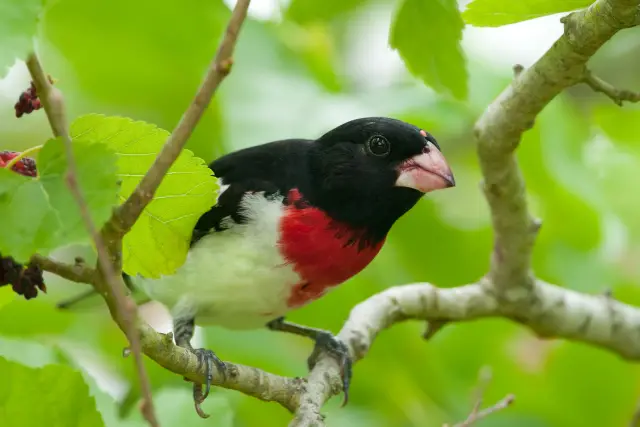
The rose-breasted grosbeak is a medium-sized songbird belonging to the Cardinalidae family. Like most birds with red chests, the rose-breasted grosbeak is highly admired for its vibrant plumage and beautiful song.
The male rose-breasted grosbeak has a striking appearance. These red-chested birds have a dark head, back, and wings, while their underparts are a vibrant rose-red color, extending from the breast down to the belly. The wings also display prominent white patches that are visible during flight.
On the other hand, the females have red chests, brownish back, and wings with streaks and light underparts. Both genders have thick, conical bills that are specialized for cracking seeds.
Rose-breasted grosbeaks can be found in a variety of habitats across North America, including deciduous forests, woodlands, and forest edges. They prefer areas with ample tree cover, as they rely on trees for nesting and foraging.
These grosbeaks primarily feed on insects during the breeding season, but they also consume a variety of seeds and berries. Their diet includes caterpillars, beetles, spiders, and other small invertebrates.
Rose-breasted grosbeaks are migratory birds. They breed in North America during the summer months and then migrate to Central and South America for the winter.
7. Painted Redstart (Myioborus pictus)
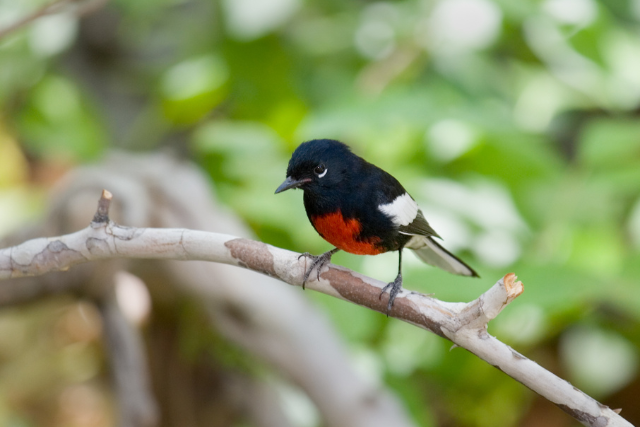
The painted redstart is a small songbird that belongs to the family Parulidae, which includes warblers. The painted redstart is a beautiful and captivating bird renowned for its stunning coloration and lively behavior. Its presence in the mountainous regions of western North America adds vibrancy to the avian biodiversity of those areas.
Like most birds with red chests, the painted redstart is a striking bird with bold and contrasting plumage. The adult male has a dark head, throat, back, wings, and tail. Their upper breast and belly are white, and red feathers on their lower breast and flanks.
The adult female has similar coloration but with duller tones. Both genders have white patches on the wings and outer tail feathers, which are highly visible in flight. Juvenile birds resemble adult females but with more brownish tones.
These redstarts are known for their active and energetic behavior. These birds frequently flick their wings and tails while foraging, displaying their bright white patches.
The painted redstart breeds in mountainous forests during the summer months.
8. House Finch (Haemorhous mexicanus)
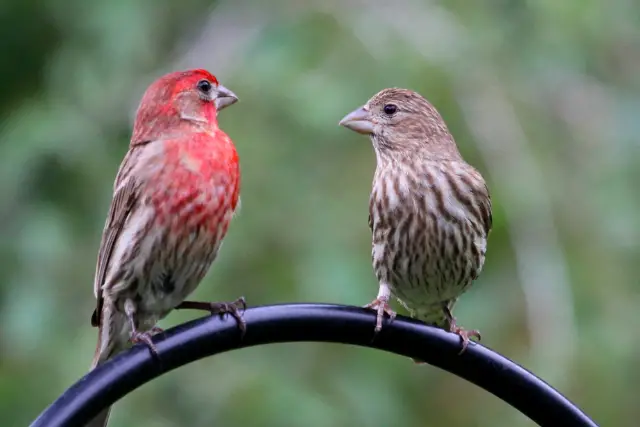
The House Finch is a North American small passerine bird known for its adaptability and ability to thrive in human-altered environments. They are often seen nesting on buildings, window ledges, and hanging flower pots.
House Finches are small birds, measuring about 5 to 6 inches (13 to 15 cm) in length. The males have a reddish-pink head and chest, a brown-streaked back, and a distinctive reddish coloration on their eyebrows, throat, and upper breast. The females have plain gray-brown plumage with some streaks.
These finches primarily feed on seeds, berries, insects, and fruits. They have a particular fondness for sunflower seeds and can often be seen at bird feeders.
These birds have a melodious song, which the males sing to attract mates and establish territories.
9. Scarlet Tanager (Piranga olivacea)
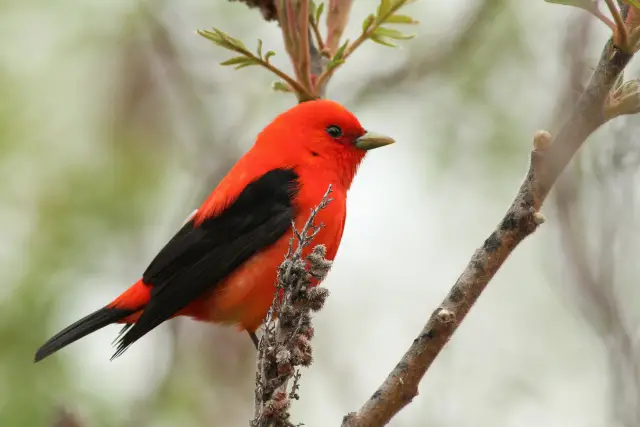
The Scarlet Tanager is a unique songbird that’s known for its striking plumage, particularly the adult male.
The adult male Scarlet Tanagers have bright red plumage, which contrasts with their black wings and tail. They have a stout, pointed beak. Females and immature birds have a more subdued appearance, with yellowish-green plumage on the upper parts and pale yellow underparts.
Scarlet Tanagers primarily feed on insects, such as beetles, wasps, bees, ants, and caterpillars. They catch their prey by flycatching or by gleaning insects from leaves and branches.
They are known for their distinctive song, which is a series of short phrases often described as a robin-like warble.
10. Scarlet Honeyeater (Myzomela sanguinolenta)
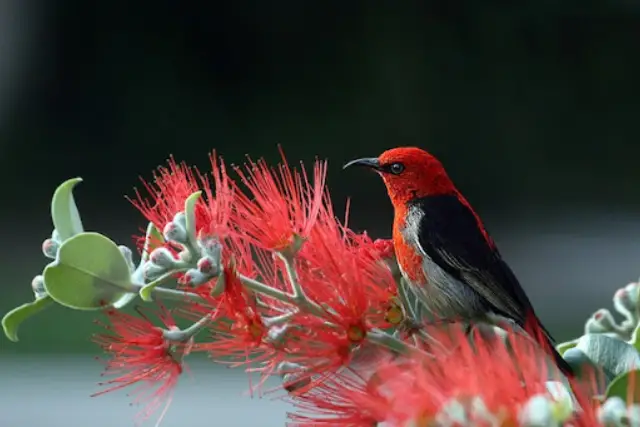
Native to Australia, the Scarlet Honeyeater (Myzomela sanguinolenta) is a small, beautiful, and charismatic bird.
The male Scarlet Honeyeater is known for its vibrant and striking plumage. It has a scarlet or crimson head, throat, and upper breast, while the rest of its body is black. It also has a black bill and reddish eyes.
On the other hand, the female has more subdued colors, with olive-green upperparts and pale yellow underparts. The Scarlet Honeyeater are small birds, measuring about 9-10 centimeters (3.5-4 inches) in length.
Scarlet Honeyeaters primarily feed on nectar from a variety of flowering plants. They have specialized brush-tipped tongues that allow them to extract sweet nectar.
They may also consume small insects and spiders as a source of protein.
These birds are generally active and agile, moving swiftly between flowers in search of nectar.
Frequently Asked Questions
Which red-chested bird has a black head?
Other than being a close relative to the black-headed grosbeaks, the Rose-breasted Grosbeaks have a black head. They have a huge bill that helps them crack seeds before consuming them. It's also loved for its beautiful sounds and plumage.
Which birds with red chests have green backs?
The Painted Bunting is one of the few birds with red chests and green backs. This bird is quite common in places like Tennessee between April and July. These finch-like creatures can't be easily mistaken for other finch birds, thanks to their green back, blue head, and red chest.
Which popular British avian has a red chest?
Like some finch birds, the bullfinch has a thick bill, black cap, and rose-red chest. It comes with a grey back, dark tail, white-and-black wings, and red breasts. The females resemble the male, but they're grayish-brown instead of bright pink.
Conclusion
As aforementioned, birds come in a wide range of color combinations. Unfortunately, there are lots of birds with red breasts visiting our backyards. And identifying one from the other can be a tad challenging for some bird lovers.
Don't get me wrong, they do beautify our backyards, but with the above details, you can determine the exact identity of the bird in your neighborhood.

